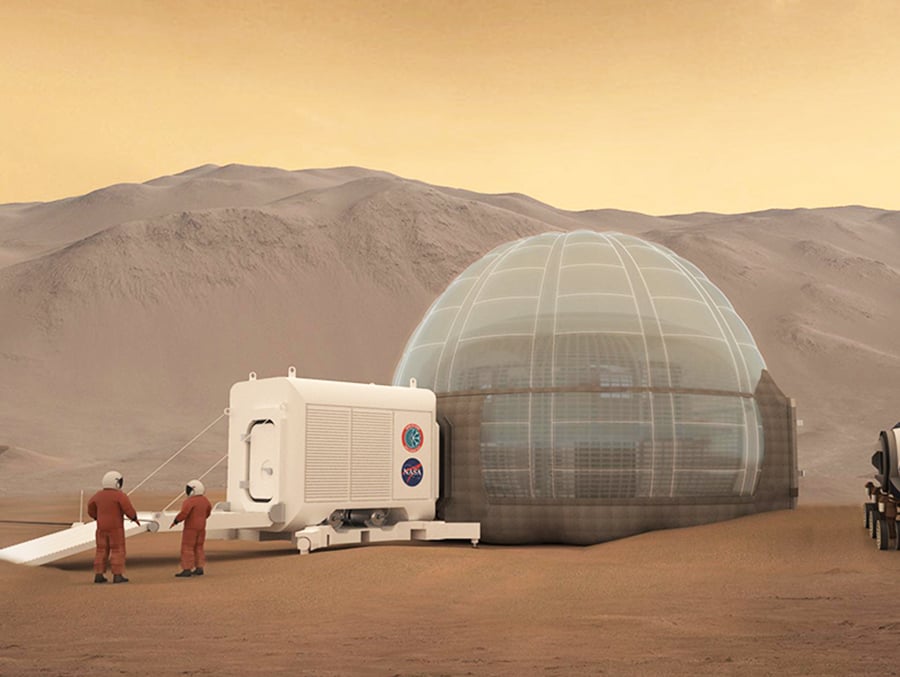
Out of This World

UTSA experts are working on two new projects with researchers at the National Aeronautics and Space Administration, boosting the university’s space-related portfolio to new heights.
Built to Last
As exploration missions beyond Earth have become more ambitious, NASA has started considering new technologies to keep habitats operational when they are not occupied by astronauts. That’s why NASA has tapped UTSA researchers to join a team that will build homes on the moon and Mars.
To help achieve this the space agency has selected UTSA to be part of its Space Technology Research Institutes to advance space-smart habitat designs, or SmartHab. This research will complement other NASA projects to help mature the mission architecture needed to meet exploration goals.
UTSA’s contingent, led by Arturo Montoya, an associate professor in civil engineering and mechanical engineering, will join NASA’s Resilient ExtraTerrestrial Habitats Institute. Seeking to design and operate resilient deep-space habitats that can adapt, absorb, and rapidly recover from expected and unexpected disruptions, the institute plans to leverage expertise in civil infrastructure with advanced technology fields such as modular and autonomous robotics and hybrid simulation.
As part of the program UTSA will receive financial support to build computational models, including the algorithms needed to create resilient moon and Mars future homes. “This grant will allow UTSA and its students to play a key role in solving the challenge of deep-space habitation, while building partnerships with NASA facilities, universities, and industries,” Montoya says.
Through an integrated effort, RETHi will mature deep-space habitats that can operate in both crewed and uncrewed configurations. The institute plans to create a cyberphysical prototype testbed of physical and virtual models to develop, deploy, and validate different capabilities. The team includes Purdue University, the University of Connecticut, and Harvard.
“Our participation in efforts to map a reality of extraterrestrial habitation as part of this initiative helps to support President Eighmy’s vision for UTSA as a great multicultural discovery enterprise and being world-engaged,” says JoAnn Browning, dean of the College of Engineering. “This grant also illustrates our emphasis on multidisciplinary research, since it brings together the fields of autonomous robotics, advanced computing methods for hybrid simulation, and sustainable civil infrastructure design.”
UTSA with the other collaborators will be funded by NASA’s Space Technology Mission Directorate, which is responsible for developing the cross-cutting, pioneering, new technologies and capabilities needed by the agency to achieve its current and future missions.
Ends of the Earth
Climate change has created extreme environmental conditions such as ocean and polar warming, and sea ice reduction. Severe weather—including stronger hurricanes, sweeping forest fires, destructive tornadoes, heat waves and drought—are now more common. Recently, soaring temperature advisories were in effect for nearly 200 million people in some of the most densely populated parts of the country, including many areas not familiar with extreme heat.
To investigate these extreme conditions, UTSA will receive $3 million from NASA to develop a new interdisciplinary Center for Advanced Measurements in Extreme Environments. This collaboration will push the boundaries of current measurement and modeling technology by conducting research in harsh and extreme environments. They will also study the challenging conditions produced when travelling at hypersonic speeds.
Christopher Combs, a Dee Howard Endowed assistant professor in the Department of Mechanical Engineering, will investigate how the extreme hypersonic flow conditions experienced during atmospheric reentry will impact the design of NASA flight vehicles. Associate professor and associate fellow in the American Institute of Aeronautics and Astronautics Kiran Bhaganagar will provide expertise on fluid dynamics, turbulence, and other computational models. Sea ice specialist Stephen Ackley and oceanographer Alberto Mestas-Nunez will complete the team.
As it evolves, CAMEE will also welcome UTSA collaborators from other academic disciplines.
“What we have in common are harsh environments where all these measurements are made, but it’s really hard to make a measurement because the conditions are so extreme,” says Combs. “Whether it’s hypersonics, where everything is incredibly hot and you have plasma and disassociated air, or the polar ice caps, where everything is frozen and you have to do things remotely, we have similar challenges.” CAMEE’s areas of research will include polar sea ice and sea level rise, the Gulf of Mexico and the polar oceans, atmospheric science and extreme event, aerodynamics, and modeling, simulation, and big data.
The UTSA center will enhance NASA’s efforts to develop a diverse workforce in earth system sciences, remote sensing technologies, computational fluid dynamics, and experimental fluid mechanics. The UTSA team also anticipates training 64 highly skilled professionals in STEM disciplines to support NASA’s mission. CAMEE participants will enroll in summer internships at three NASA centers—the Goddard Space Flight Center, Jet Propulsion Laboratory, and Langley Research Center. Hands-on workshops will be offered to K-12 teachers to further develop an interest in earth system science, measurement, and data analytics among the next generation. The center will also create several experiential learning and unique training opportunities for UTSA students.
In addition to helping solve grand challenges posed by extreme environments, the UTSA researchers believe that advanced measurement techniques could lead to breakthroughs in data acquisition for similarly extreme environments experienced on extraterrestrial surfaces during atmospheric entry of NASA’s space exploration efforts.

